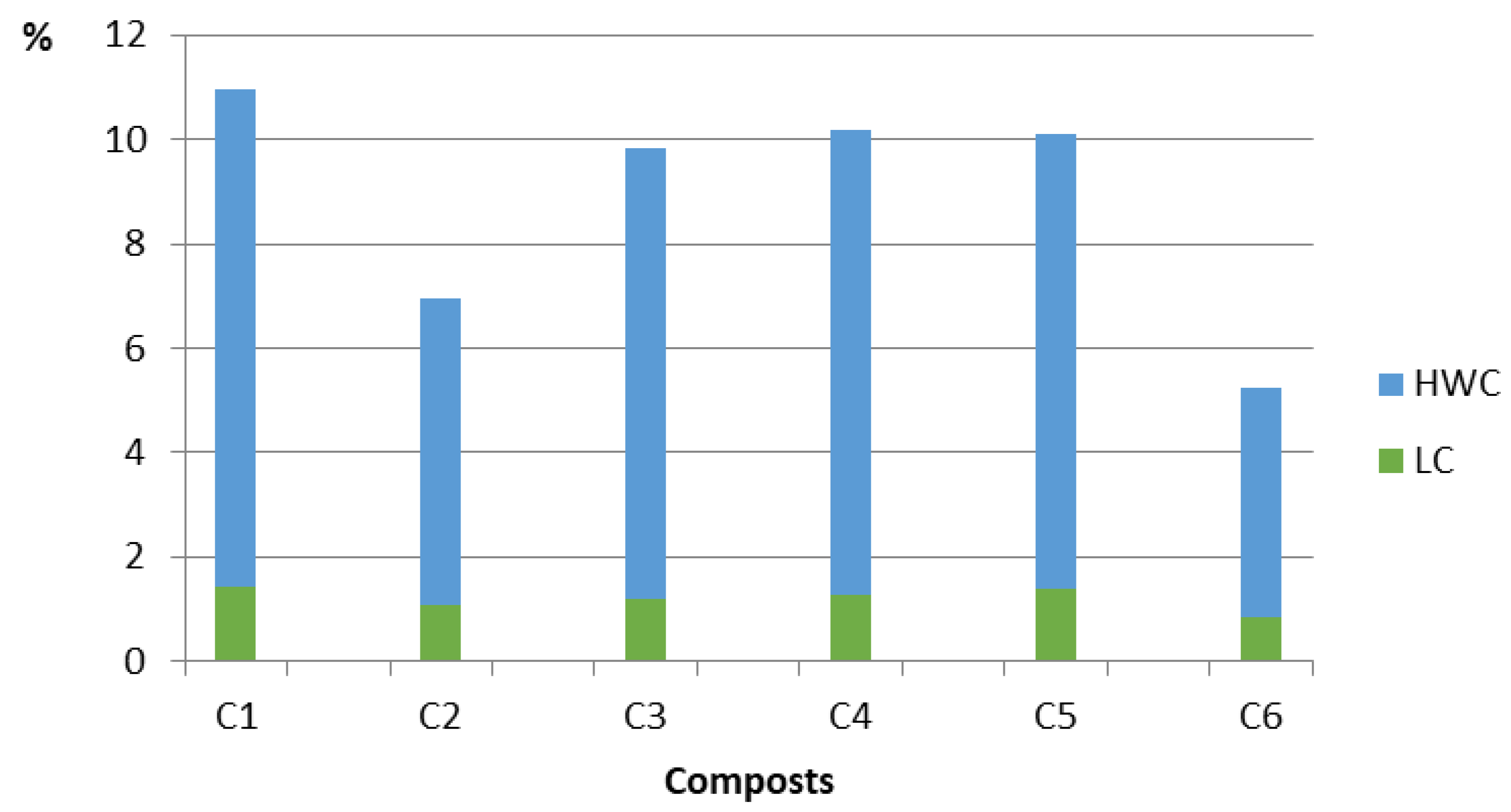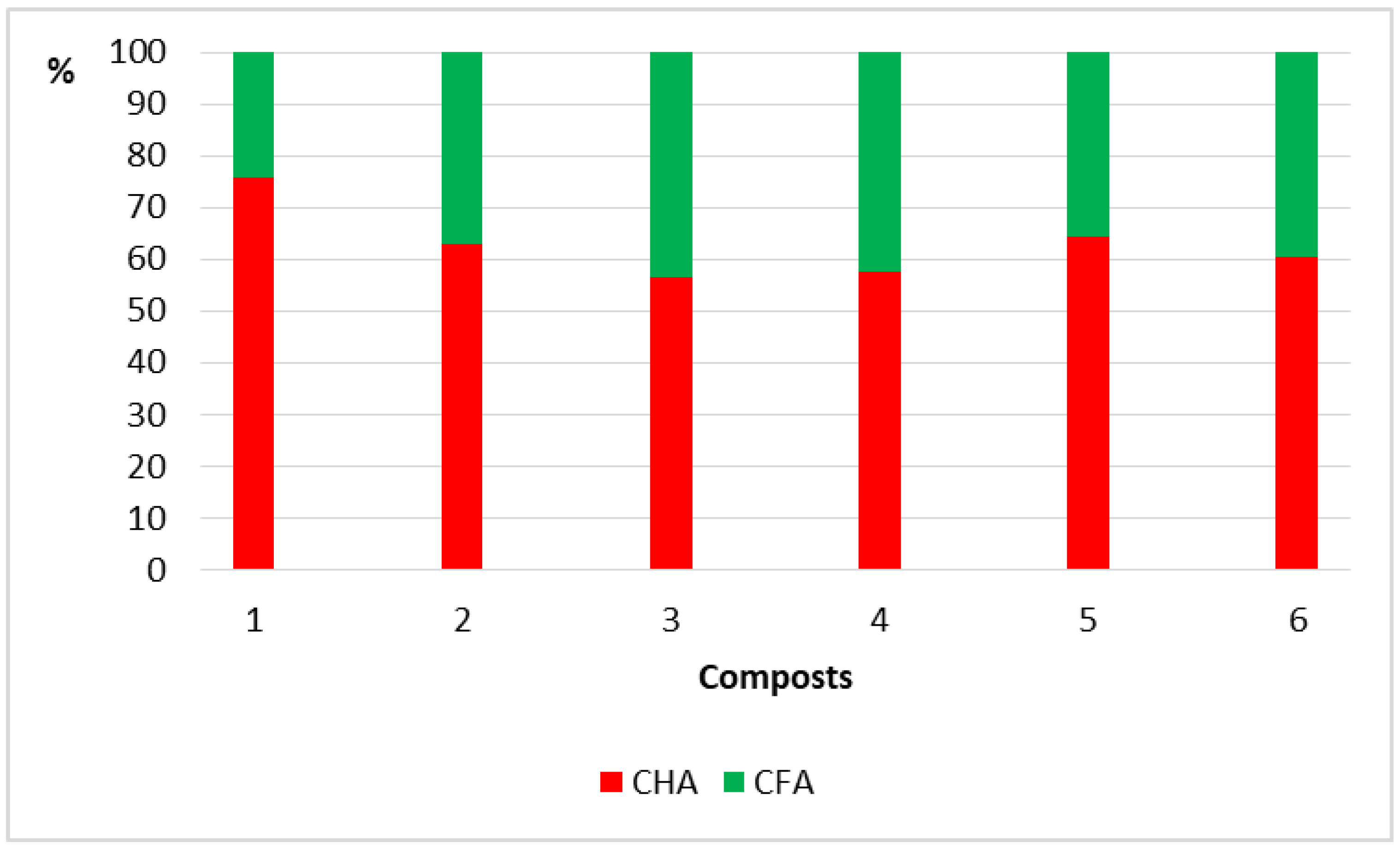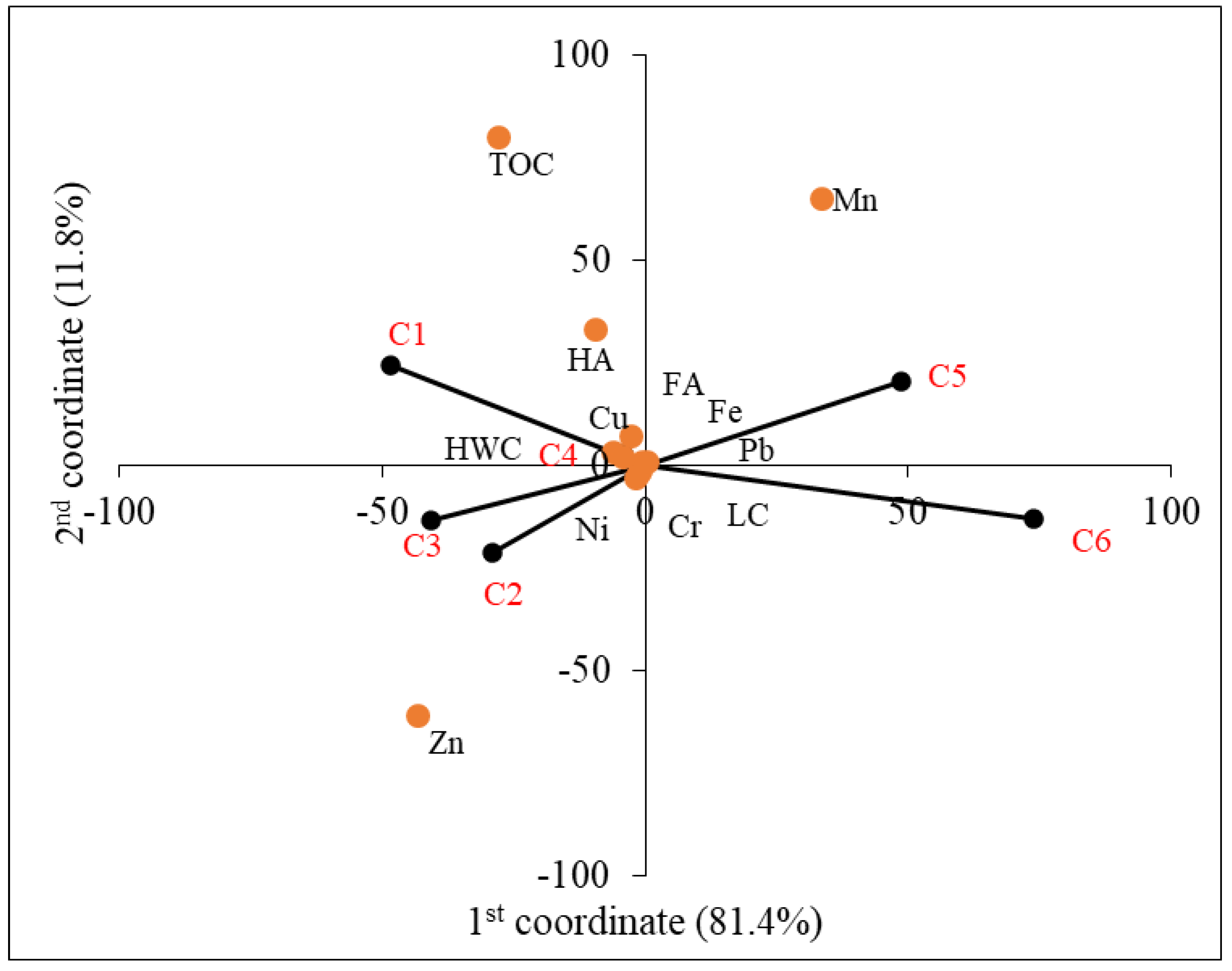Evaluation of Agricultural Value of Composts Prepared from Municipal Biowastes in Different Conditions of Composting Process
Abstract
:1. Introduction
2. Materials and Methods
2.1. Composting Procedure and Raw Materials
2.2. Chemical Analysis of Compost
2.3. Statistical Analysis
3. Results and Discussion
3.1. Basic Properties of Composts
3.2. Characteristic of Various Carbon Combinations in Composts
3.3. Amount of Bioavailable Metals in Composts
4. Conclusions
Author Contributions
Funding
Institutional Review Board Statement
Informed Consent Statement
Data Availability Statement
Conflicts of Interest
References
- Jakubus, M.; Stejskal, B. Municipal solid waste management systems in Poland and the Czech Republic. A comparative study. Environ. Prot. Eng. 2020, 46, 61–78. [Google Scholar] [CrossRef]
- Central Statistical Office. Environment Protection, Warszawa. 2019. Available online: https://stat.gov.pl/obszary-tematyczne/srodowisko-energia/srodowisko/ochrona-srodowiska-2019,1,20.html (accessed on 25 April 2022).
- Ordinance of the Economy and Labor Minister on Criteria and Procedures for Admission of Waste to Storage in a Type of Waste. Journal of Laws 2015, Item 1277. Available online: https://isap.sejm.gov.pl/isap.nsf/DocDetails.xsp?id=WDU20150001277 (accessed on 25 April 2022). (In Polish)
- Council Directive 1999/31/EC of 26 April 1999 on the Landfill of Waste. Available online: https://eur-lex.europa.eu/legal-content/EN/TXT/PDF/?uri=CELEX:31999L0031&from=EN (accessed on 25 April 2022).
- Scarlat, N.; Fahl, F.; Dallemand, J.-F. Status and opportunities for energy recovery from municipal solid waste in Europe. Waste Biomass Valor. 2019, 10, 2425–2444. [Google Scholar] [CrossRef] [Green Version]
- Communication from the Commission to the European Parliament, the Council, the European Economic and Social Committee and the Committee of the Region. Toward a Circular Economy: Zero Waste Programme For Europe”. COM (2014) 398 Final. Available online: https://eur-lex.europa.eu/resource.html?uri=cellar:aa88c66d-4553-11e4-a0cb-01aa75ed71a1.0022.03/DOC_1&format=PDF (accessed on 25 April 2022).
- Jakubus, M.; Michalak-Oparowska, W. Social participation in the biowaste disposal system before and during the COVID-19 pandemic. A case study for Poznań. Environ. Prot. Eng. 2021, 47, 109–123. [Google Scholar] [CrossRef]
- Thomas, C.L.; Acquah, G.E.; Whitmore, A.P.; McGrath, S.P.; Haefele, S.M. The effect of different organic fertilizer on yield and soil and crop nutrient concentrations. Agronomy 2019, 9, 776. [Google Scholar] [CrossRef] [Green Version]
- Jakubus, M. A comparative study of composts prepared from various organic waste based on biological and chemical parameters. Agronomy 2020, 10, 869. [Google Scholar] [CrossRef]
- Santos, C.; Fonseca, J.; Aires, A.; Coutinho, J.; Trindade, H. Effect of different rates of spent coffee grounds (SCG) on composting process, gaseous emissions and quality of end-product. Waste Manag. 2017, 59, 37–47. [Google Scholar] [CrossRef]
- Sharma, B.; Sarkar, A.; Singh, P.; Singh, R.P. Agricultural utilisation of biosolids: A review on potential effects on soil and plant grown. Waste Manag. 2017, 64, 117–132. [Google Scholar] [CrossRef]
- Jakubus, M.; Bakinowska, E.; Gałka, B. The quantitative changes of nutrients in two contrasting soils amended with sewage sludge compost evaluated by various statistical tools. Acta Agric. Scand. Sect. B Soil Plant Sci. 2018, 68, 39–49. [Google Scholar] [CrossRef]
- Rigby, H.; Clarke, B.O.; Pritchard, D.L.; Meehan, B.; Beshah, F.; Smith, S.R.; Porter, N.A. A critical review of nitrogen mineralization in biosolids-amended soil, the associated fertiliser value for crop production and potential for emissions to the environment. Sci. Total Environ. 2016, 541, 1310–1338. [Google Scholar] [CrossRef]
- Regulation of the Minister of Agriculture and Rural Development of 18 June 2008. Journal of Laws 2008, Item 119. Available online: https://isap.sejm.gov.pl/isap.nsf/DocDetails.xsp?id=WDU20080200119 (accessed on 25 April 2022). (In Polish)
- Commission Regulation (EC) No 889/2008. Available online: https://eur-lex.europa.eu/legal-content/EN/TXT/PDF/?uri=CELEX:32008R0889&from=EN (accessed on 25 April 2022).
- Jakubus, M.; Graczyk, M. Evaluation of usability of single extractors in chemical analysis of composts at the assistance of principal component analysis. Biom. Lett. 2015, 52, 115–130. [Google Scholar] [CrossRef] [Green Version]
- PN-ISO 14870:2001; Soil Quality—Extraction of Trace Elements by Buffered DTPA Solution. International Organization for Standardization: Genève, Switzerland, 2001.
- Orlov, D.S.; Grišina, L.A. Guide of Humus Chemistry; IMU: Moscow, Russia, 1981. (In Russian) [Google Scholar]
- Loginov, W.; Wisniewski, W.; Gonet, S.S.; Cieścinska, B. Fractionation of organic carbon based on susceptibility to oxidation. Pol. J. Soil Sci. 1987, 20, 47. (In Polish) [Google Scholar]
- Ghani, A.; Dexter, M.; Perrott, K.W. Hot-water extractable carbon in soils: A sensitive measurement for determining impacts of fertilisation, grazing and cultivation. Soil. Biol. 2003, 35, 1231. [Google Scholar] [CrossRef]
- Dziadowiec, H.; Gonet, S. A methodological guide to soil organic matter research. PTG 1999, 120, 43. (In Polish) [Google Scholar]
- Mushtaq, M.; Iqbal, M.K.; Khalid, A.; Khan, R.A. Humification of poultry waste and rice husk using additives and its application. Int. J. Recycl. Org. Waste Agric. 2019, 8, 15–22. [Google Scholar] [CrossRef] [Green Version]
- Kayzer, D.; Frankowski, P.; Zbierska, J.; Staniszewski, R. Evaluation of trophic parameters in newly built reservoir using canonical variates analysis. In XLVIII Seminar of Applied Mathematics; Zielinski, W., Kuchar, L., Michalski, A., Kazmierczak, B., Eds.; Book Series: ITM Web of Conferences; EDP Sciences: Les Ulis, France, 2018; Volume 23, p. 00019. [Google Scholar] [CrossRef] [Green Version]
- Gao, M.; Liang, F.; Yu, A.; Li, B.; Yang, L. Evaluation of stability and maturity during forced –areation composting of chicken manure and sawdust at different C/N ratio. Chemosphere 2010, 78, 614–619. [Google Scholar] [CrossRef]
- Jakubus, M. Evaluation of maturity and stability parameters of composts prepared with sewage sludge. Fresenius Environ. Bull 2013, 22, 3398–3414. [Google Scholar]
- Azim, K.; Soudi, B.; Boukhari, S.; Perissol, C.; Roussos, S.; Alami, T. Composting parameters and compost quality: A literature review. Org. Agric. 2018, 8, 141–158. [Google Scholar] [CrossRef]
- Antil, R.S.; Raj, D.; Abdalla, N.; Inubushi, K. Physical, chemical and biological parameters for compost maturity assessment. In Composting for Sustainable Agriulture; Maheshwari Dinesh, K., Ed.; Springer: Berlin/Heidelberg, Germany, 2014; pp. 83–102. [Google Scholar]
- Asquer, C.; Cappai, G.; Gioannis, G.; Muntoni, A.; Piredda, M.; Spiga, D. Biomass ash reutilization as an additive in the composting process of organic fraction of municipal solid waste. Waste Manag. 2017, 69, 127–135. [Google Scholar]
- Bernal, M.P.; Alburquerque, J.A.; Moral, R. Composting of animal manures and chemical criteria for compost maturity assessment. A review. Bioresour. Technol. 2009, 100, 5444–5453. [Google Scholar] [CrossRef]
- Ozdemir, S.; Dede, G.; Dede, O.H.; Turo, S.M. Composting of sewage sludge with mole cricket: Stability, maturity and sanitation aspects. Int. J. Environ. Sci. Technol. 2019, 16, 5827–5834. [Google Scholar] [CrossRef]
- Iglesias-Jiménez, E.; Pérez-García, V. Determination of maturity indices for city refuse composts. Agric. Ecosys. Environ. 1992, 38, 331–343. [Google Scholar] [CrossRef]
- Alvarenga, P.; Mourinha, C.; Farto, M.; Santos, T.; Palma, P.; Sengo, J.; Morais, M.C.; Cunha-Queda, C. Quality assessment of a battery of organic wastes and composts using maturity, stability and enzymatic parameters. Waste Biomass Valor. 2016, 7, 455–465. [Google Scholar] [CrossRef]
- Bustamante, M.A.; Alburquerque, J.A.; Restrepo, A.P.; de la Fuente, C.; Paredes, C.; Moral, R.; Bernal, M.P. Co-composting of the solid fraction of anaerobic digestates, to obtain added-value materials for use in agriculture. Biomass Bioenergy 2012, 43, 26–35. [Google Scholar] [CrossRef]
- Jakubus, M.; Michalak-Oparowska, W. Valorization of quality of vermicomposts and composts using various parameters. Agriculture 2022, 12, 293. [Google Scholar] [CrossRef]
- Zmora-Nahum, S.; Markovitch, O.; Tarchitzky, J.; Chen, Y. Dissolved organic carbon (DOC) as a parameter of compost maturity. Soil Biol. Biochem. 2005, 37, 2109–2116. [Google Scholar] [CrossRef]
- Corvasce, M.; Zsolnay, A.; D’Orazio, V.; Lopez, R.; Miano, T.M. Characterization of water extractable organic matter in a deep soil profile. Chemosphere 2006, 62, 1583–1590. [Google Scholar] [CrossRef]
- Lv, B.; Xing, M.; Yang, J.; Qi, W.; Lu, Y. Chemical and spectroscopic charactrisation of water extractable organic matter during vermicomposting of cattle dung. Bioresour. Technol. 2013, 132, 320–326. [Google Scholar] [CrossRef]
- Li, H.; Li, Y.; Li, C. Characterisation of humic acids and fulvic acids derived from sewage sludge. Asian J. Chem. 2013, 25, 10087. [Google Scholar] [CrossRef]
- Li, S.; Li, D.; Li, J.; Li, G.; Zhang, B. Evaluation of humic substances during co-composting of sewage sludge and corn stalk under different aeration rates. Bioresour. Technol. 2017, 245, 1299. [Google Scholar] [CrossRef]
- Yu, H.; Xie, B.; Khan, R.; Shen, G. The changes in carbon, nitrogen components and humic substances during organic-inorganic aerobic co-composting. Bioresour. Technol. 2019, 271, 228. [Google Scholar] [CrossRef]
- Guo, X.-X.; Liu, H.-T.; Wu, S.-B. Humic substances developed during organic waste composting: Formation mechanisms, structural properties, and agronomic functions. Sci. Total Environ. 2019, 662, 501–510. [Google Scholar] [CrossRef] [PubMed]



| Parameter | Unit | Minimum Value | Maximum Value |
|---|---|---|---|
| pH | 6.6 | 7.2 | |
| Ntot | g∙kg−1 | 5.2 | 26.8 |
| TOC | 210.3 | 348.4 | |
| C:N | 14:1 | 39:1 | |
| Fe | g∙kg−1 | 1.4 | 8.8 |
| Mn | mg∙kg−1 | 72.4 | 175.6 |
| Zn | 22.8 | 138.7 | |
| Cu | 1.85 | 17.5 | |
| Pb | 5.1 | 11.7 | |
| Cr | 3.2 | 15.3 | |
| Ni | 1.4 | 5.9 |
| Compost Number/Raw Materials * Used | Size of Agglomeration | Method of Composting | Maturation Period |
|---|---|---|---|
| C1/garden and park wastes, food and kitchen wastes from households and restaurants | Medium | AC | Approximately 3 months depending on weather conditions |
| C2/as above | Medium | AC | Approximately 6 months depending on weather conditions |
| C3/as above | Large | AC | Approximately 3 months depending on weather conditions |
| C4/as above | Large | AC | Approximately 6 months depending on weather conditions |
| C5/as above | Small | AC | Approximately 6 months depending on weather conditions |
| C6/food scraps from kitchen, and yard trimmings as plant residues and mowed grass clippings | Large | AANC | Approximately 6 months depending on weather conditions |
| Compost Number | pH * | OM (g∙kg−1) | C:N | Q4/6 | HI (%) | HR (%) | DP (CHA:CFA Ratio) |
|---|---|---|---|---|---|---|---|
| 1 | 7.1 | 337.6 | 11:1 | 13.7 | 28.7 | 21.8 | 3.1 |
| 2 | 7.1 | 262.6 | 13:1 | 14.4 | 14.3 | 11.0 | 1.7 |
| 3 | 6.5 | 319.6 | 13:1 | 14.3 | 22.6 | 13.6 | 1.5 |
| 4 | 7.2 | 279.9 | 14:1 | 7.2 | 19.9 | 11.1 | 1.4 |
| 5 | 7.0 | 328.4 | 11:1 | 7.1 | 20.8 | 15.3 | 1.8 |
| 6 | 7.3 | 243.8 | 13:1 | 6.6 | 8.9 | 6.3 | 1.3 |
| Compost Number | TOC * | CHS | CHA | CFA | HWC | LC |
|---|---|---|---|---|---|---|
| C1 | 163.68 a | 46.97 a | 35.64 a | 11.32 a | 15.57 a | 2.50 a |
| C2 | 127.49 c | 18.24 d | 11.48 d | 6.76 b | 7.49 d | 1.35 cd |
| C3 | 152.32 ab | 34.23 b | 20.69 b | 13.53 a | 13.04 c | 1.84 b |
| C4 | 135.38 b | 26.98 c | 15.50 c | 11.48 a | 12.11 cd | 1.71 bc |
| C5 | 159.62 a | 33.17 b | 21.38 b | 11.79 a | 13.85 b | 2.30 a |
| C6 | 118.81 c | 10.02 e | 5.65 e | 4.37 c | 4.97 e | 0.93 d |
| Cr | Cu | Zn | Pb | LC *** | CHS | CHA | CFA | TOC | |
|---|---|---|---|---|---|---|---|---|---|
| HWC | 0.613 ** | 0.727 ** | 0.655 ** | 0.496 * | 0.620 ** | 0.652 ** | 0.625 ** | 0.530 ** | 0.671 ** |
| TOC | n.s. | n.s. | n.s. | n.s. | 0.860 ** | 0.939 ** | 0.860 ** | 0.877 ** | |
| FA | n.s. | n.s. | n.s. | 0.532 ** | 0.799 ** | 0.780 ** | 0.613 ** | ||
| HA | n.s. | n.s. | n.s. | n.s. | 0.796 ** | 0.973 ** | |||
| HS | n.s. | n.s. | n.s. | n.s. | 0.865 ** |
| Compost Number | Fe | Mn | Zn | Cu | Pb | Ni | Cr |
|---|---|---|---|---|---|---|---|
| C1 | 2.02 cd | 70.61 bc | 65.33 c | 10.43 b | 4.55 cd | 2.54 c | 2.70 c |
| C2 | 2.90 b | 81.18 b | 112.84 a | 13.67 a | 5.97 b | 4.66 a | 4.45 a |
| C3 | 2.94 b | 72.92 bc | 117.53 a | 8.75 c | 9.88 a | 3.23 b | 3.42 b |
| C4 | 2.42 c | 60.04 c | 85.60 b | 14.61 a | 10.33 a | 2.86 bc | 2.66 cd |
| C5 | 4.58 a | 166.12 a | 54.40 d | 9.32 c | 5.11 bc | 3.23 b | 2.07 d |
| C6 | 1.90 d | 84.37 b | 28.21 e | 2.35 d | 4.00 d | 1.55 d | 1.18 c |
Publisher’s Note: MDPI stays neutral with regard to jurisdictional claims in published maps and institutional affiliations. |
© 2022 by the authors. Licensee MDPI, Basel, Switzerland. This article is an open access article distributed under the terms and conditions of the Creative Commons Attribution (CC BY) license (https://creativecommons.org/licenses/by/4.0/).
Share and Cite
Jakubus, M.; Spychalski, W. Evaluation of Agricultural Value of Composts Prepared from Municipal Biowastes in Different Conditions of Composting Process. Agronomy 2022, 12, 1438. https://doi.org/10.3390/agronomy12061438
Jakubus M, Spychalski W. Evaluation of Agricultural Value of Composts Prepared from Municipal Biowastes in Different Conditions of Composting Process. Agronomy. 2022; 12(6):1438. https://doi.org/10.3390/agronomy12061438
Chicago/Turabian StyleJakubus, Monika, and Waldemar Spychalski. 2022. "Evaluation of Agricultural Value of Composts Prepared from Municipal Biowastes in Different Conditions of Composting Process" Agronomy 12, no. 6: 1438. https://doi.org/10.3390/agronomy12061438
APA StyleJakubus, M., & Spychalski, W. (2022). Evaluation of Agricultural Value of Composts Prepared from Municipal Biowastes in Different Conditions of Composting Process. Agronomy, 12(6), 1438. https://doi.org/10.3390/agronomy12061438







